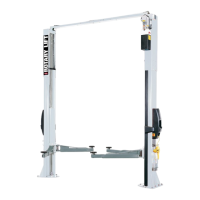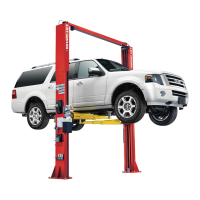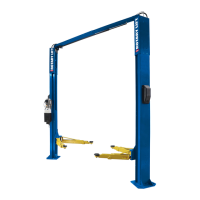
Do you have a question about the Rotary SPO55E and is the answer not in the manual?
| Brand | Rotary |
|---|---|
| Model | SPO55E |
| Category | Lifting Systems |
| Language | English |
Provides context and guidelines for using the operating manual.
Explains hazard classification symbols and their meanings.
Specifies the qualifications and responsibilities of lift operators.
Lists fundamental safety rules for operating the lift.
Details load capacity and weight distribution guidelines.
Prohibits modifications and their consequences.
Defines roles and qualifications for inspection personnel.
Outlines requirements for authorized maintenance and installation personnel.
Specifies the timing and procedure for safety inspections.
Identifies and illustrates the main components of the lift.
Defines safe operating areas and potential hazards around the lift.
Details safety features like lockable switches, guards, and limit bars.
Explains the functions of buttons and handles on the control panel.
Lists pre-operation checks and preparations before loading a vehicle.
Provides instructions for safely positioning and loading vehicles onto the lift.
Details the procedure for raising the lift with a vehicle.
Offers safety advice for when the lift is in use.
Specifies checks to perform before lowering the lift.
Provides instructions for safely lowering the lift.
Instructions for safely removing a vehicle from the lift.
Explains how to safely turn off the lift.
Guides operators through basic troubleshooting steps.
Lists advanced troubleshooting for maintenance personnel.
Specifies required skills and authorization for repair work.
Lists safety rules for maintenance and repair activities.
Details general safety and procedures for maintenance tasks.
Outlines daily checks to ensure operational safety.
Lists tasks for monthly maintenance.
Details maintenance tasks required every six months.
Outlines maintenance procedures for annual checks.
Specifies approved hydraulic oils and safety precautions.
Step-by-step guide for hydraulic oil maintenance.
General guidelines and procedures for carrying out repairs.
Instructions for replacing worn cables or sheaves.
Information on how the lift is packaged and transported.
Steps for safely unloading the lift components.
Recommended conditions for storing lift components.
Key safety guidelines before starting assembly.
Step-by-step guide for assembling the lift.
Requirements for the installation site and foundation.
Steps required before physically assembling the lift.
Details on assembling and positioning the lift columns.
Steps for assembling the overhead structure.
Instructions for assembling the hydraulic power unit.
Specific procedure for tightening flared fittings.
Instructions for installing and tensioning the equalizing cables.
Guides the installation of latch cables for M version lifts.
Instructions for connecting electrical components and wiring.
Instructions for assembling and checking the overhead switch.
Steps for installing seals, covers, and wire chases for CE compliance.
Guides the installation of lifting arms and their safety restraints.
Instructions for installing miscellaneous parts like arm guards.
Instructions for installing optional arm extensions.
Verifies the lift's basic functions after assembly.
Procedure for testing the hydraulic system for leaks and function.
Steps to remove air from the hydraulic system.
Guide for checking and adjusting equalizer cable tension.
Procedure for checking and adjusting latch cables on M series lifts.
Guidelines for environmentally safe disposal of materials.
Instructions for disposing of packaging materials.
Proper disposal methods for oils, grease, and chemicals.
How to dispose of metal and electronic waste components.





